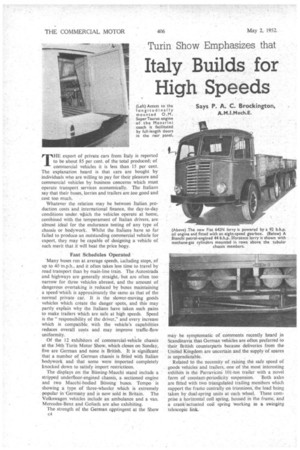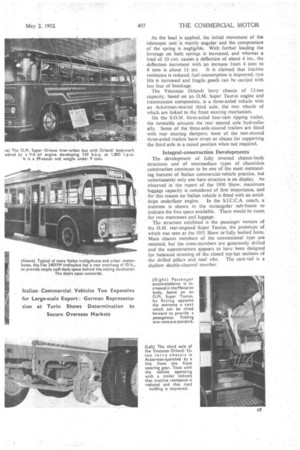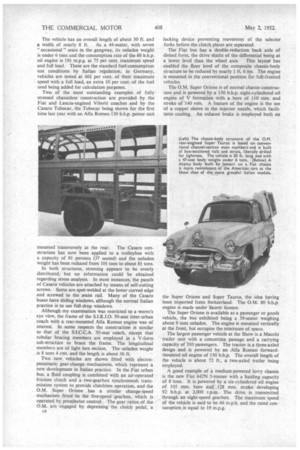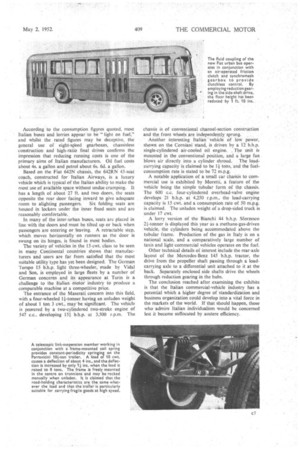Turin Show Emphasizes that
Page 42

Page 43

Page 44

Page 45

If you've noticed an error in this article please click here to report it so we can fix it.
Italy Builds for High Speeds
THE export of private cars from Italy is reported to be about 85 per cent. of the total produced; of commercial vehicles it is less than 15 per cent. The explanation heard is that cars are bought by individuals who are willing to pay for their pleasure and commercial vehicles by business concerns which must operate transport services economically. The Italians say that their buses, lorries and trailers are loo good and cost too much.
Whatever the relation may be between Italian. production costs and international finance, the day-to-day conditions under: wIlich the vehicles operate at home, combined with the temperament of Italian drivers, are almost ideal for the endurance testing of any type of chassis or bodywork. Whilst the Italians have so far failed to produce an outstanding commercial vehicle for export, they may be capable of designing a vehicle of such merit that it will beat the price bogy.
Fast Schedules Operated
"Many buses run at average speeds, iacluding stops, of up to 40 'm.p.h., and it often takes less time to travel by road transport than by main-line train. The Autostrada and highways are generally straight, but are often too narrow for three vehicles abreast, and the amount of dangerous overtaking is reduced by buses maintaining a speed'whiCh is approximately the same as that of the normal private. car. It is the slower-moving goods vehicles which create the danger spots, and this may partly explain why the Italians have taken such pains to make trailers which are safe at high speeds. Speed is the " responsibility of the driver," and every increase which is compatible_ with the vehicle's capabilities reduces overall costs and may improve traffic-flow uniformity. , Of the 12 exhibitors of commercial-vehicle chassis at the 34th Turin Motor Show, which closes on Sunday, five are German and none is British. It is significant that a number of German chassis is fitted with Italian bodywork and that some were imported completely knocked down to satisfy import restrictions.
The displays on the Biissing-Macchi stand include a stripped underfloor-engineAl chassis, a sectioned engine and two Macchi-bodied Bussing buses. Tempo ' is showing a type of three-wheeler which is extremely popular in•Germany and is now sold in Britain. The Volkswagen vehicles include an ambulance and a van. Mercedes-Benz and Goliath are also exhibiting.
The strength of the German captingent at the Show c4 may be symptomatic of comments recently heard jn Scandinavia that German vehicles are often preferred to their British counterparts because deliveries from the United Kingdom are uncertain and the supply of spares is unpredictable.
Related to the necessity of raising the safe speed of goods vehicles and trailers, one of the, most interesting exhibits is the Parravicini 101-ton trailer with a novel form of constant-periodicity suspension. Both axles are fitted with two triangulated trailing members which support the frame centrally on trunnions, the load being taken by dual-spring units at each wheel. These comprise a horizontal coil spring, housed in the frame, and a crank-actuated coil spring working in a swinging telescopic link.
As the load is applied, the initial movement of the telescopic unit is mainly angular and the compression of the spring is negligible. With further loading the leverage on both springs is increased, and whereas a load of 10 cwt. causes a deflection of about 4 ins., the deflection increment with an increase from 4 tons to
8 tons is about lf inS. It is claimed that tractive resistance is reduced, fuel consumption is improved, tyre life is increased and fragile goods can be carried with less fear of breakage.
The Vincenzo Orlandi lorry chassis of 12-ton capacity, based on an OM. Super Taurus engine and transmission components, is a three-axled vehicle with an Ackerman-steered third axle, the two wheels of which are linked to the front steering mechanism.
On the S.O.M. three-axled four-ram tipping trailer, the turntable actuates the rear steered axle hydraulically. Some of the three-axle-steered trailers are fitted with rear steering dampers; most of the non-steered three-axled trailers have struts or chains for supporting the third axle in a raised position when not required.
Integral-construction Developments
The development of fully stressed chassis-body structures and of intermediate types of chassisless construction continues to be one of the most outstanding features of Italian commercial-vehicle practice, but unfortunately only one bare structure is on display. As observed in the report of the 1950 Show, maximum luggage capacity is considered of first importance, and for this reason no Italian vehicle is fitted with an amid ships underfloor engine. In the S.I.C.C.A. coach, a mattress is shown in the rectangular sub-frame to indicate the free space available. There would be room for two mattresses and luggage.
The structure exhibited is the passenger version of the O.M. rear-engined Super Taurus, the prototype of which was seen at the 1951 Show in-fully bodied form. Main chassis members of the conventional type are retained, but the cross-members are generously drilled and the superstructure appears to have been designed for balanced stressing of the closed top-hat sections of
the drilled pillars and roof ribs. The cant-rail is a shallow double-channel member. The vehicle has an overall length of about 30 ft. and a width of nearly 8 ft. As a 44-seater, with seven " occasional " seats in the gangway, its unladen weight is under 6 tons and the consumption rate of the 80 b.h.p. oil engine is 191 m.p.g. at 75 per cent. maximum speed and full load. These are the standard fuel-consumption test conditions by Italian regulation; in Germany, vehicles are tested at 661 per cent. of their maximum speed with a full load, an extra 10 per cent.. of the fuel used being added for calculation purposes.
Two of the most outstanding examples of fully stressed chassisIess construction are provided by the Fiat and Lancia-engined Viberti coaches and by the Casaro Tubocar, the Tubocar being shown for the first time last year with an Alfa Romeo 130 b.h.p. power unit mounted transversely at the rear. The Casaro construction has now been applied to a trolleybus with a capacity of 81 persons (37 seated) and the unladen weight has been reduced from 104 tons to about 81 tons.
In both structures, stressing appears to be evenly distributed, but no information could be obtained regarding stress analysis. In most instances, the panels of Casaro vehicles are attached by means of self-cutting screws. Some are spot-welded at the lower curved edge and screwed to the yvaist rail. Many of the Casaro buses have sliding windows, although the normal Italian practice is to use fUll-drop windows.
Although my examination was restricted to a worm's eye view, the frame of the S.I.R.I.O. 50-seat inter-urban coach with a rear-mounted Alfa Romeo engine was of interest. In some respects the construction is similar to that of the S.I.C.C.A. 50-seat coach, except that tubular bracing members are employed in a V-form sub-structure to brace the frame. The longitudinal members are of light box section. The unladen weight is 8 tons 4 cwt. and the length is about 36 ft.
Two new vehicles are shown fitted with electropneumatic gear-change mechanisms, which represent a new development in Italian practice. In the Fiat urban bus, a fluid coupling is combined with an air-operated friction clutch and a two-gearbox synchromesh transmission system to provide clutchless operation, and the O.M. Super Orione has a similar change-speed mechanism fitted to the five-speed gearbox, which is operated. by preselector control. The gear ratios of the 0.M. are engaged by depressing the clutch pedal, a
c6 locking device preventing movement of the selector forks before the clutch plates are separated.
The Fiat bus has a double-reduction back axle of dished form, the drive shafts of the differential being at a lower level than the wheel axis. This layout has enabled the floor level of the composite chassis-body structure to be reduced by nearly 1 ft. 6 ins. . The engine is mounted in the conventional position for full-fronted vehicles.
The O.M. Super Orione is of normal chassis construction and is powered by a 130 b.h.p. eight-cylindered oil engine of V formation with a bore of 110 mm. and stroke of 140 mm. A feature of the engine is the use of a copper sleeve in the injector nozzle, which facilitates cooling. An exhaust brake is employed both on the Super Orione and Super Taurus, the idea having been imported from Switzerland. The O.M. 80 b.h.p. engine is made under Saurer licence.
The Super Orione is available as a passenger or goods vehicle, the bus exhibited being a 59-seater weighing about 9 tons unladen. The engine is mounted vertically at the front, but occupies the minimum of space.
The largest passenger vehicle at the Show is a Macchi trailer unit with a concertina passage and a carrying capacity of 310 passengers. The tractor is a three-axled design and is powered by an Alfa Romeo forwardmounted oil engine of 130 b.h.p. The overall length of the vehicle is about 72 ft., a two-axled trailer being employed.
A good example of a medium-powered lorry chassis is the new Fiat 642N .5-tonner with a hauling capacity of 8 tons. It is powered by a six-cylindered oil engine of 105 mm. bore and 128 mm. stroke • developing 92 b.h.p. at 2,000 r.p.m. The drive is transmitted through an eight-speed gearbox. The maximum speed of the vehicle is said to be 46 m.p.h. and the rated consumption is equal to 19 m.p.g.
According to the consumption figures quoted, most Italian buses and lorries appear to be "light on fuel," and whilst the rated figures may be deceptive, the general use of eight-speed gearboxes, chassisless construction and high-ratio final drives confirms the impression that reducing running costs is one of the primary aims of Italian manufacturers. Oil fuel costs about 4s. a gallon and petrol about 6s. 6d. a gallon.
Based on the Fiat 642N chassis, the 642RN 43-scat coach, constructed for Italian Airways, is a luxury vehicle which is typical of the Italian ability to make the most use of available space without undue cramping. It has a length of about 27 ft. and two doors, the seats opposite the rear door facing inward to give adequate
room to alighting passengers. Six folding seats are housed in lockers under the inner fixed seats and are reasonably comfortable.
In many of the inter-urban buses, seats are placed in line with the doors and must be tilted up or back when passengers are entering or leaving. A retractable step, which moves horizontally on runners as the door is swung on its hinges, is found in most bodies.
The variety of vehicles in the 15-cwt. class to be seen in many ,Continental countries shows that manufacturers and users are far from satisfied that the most suitable utility type has yet been designed. The German Tempo 15 b.h.p. light three-wheeler, made by Vidal and Son, is employed in large fleets by a number of German concerns and its appearance at Turin is a challenge to the Italian inottir industry to produce a comparable machine at a competitive price.
The entrance of the Maserati concern into this field, with a four-wheeled 14-tonner having an unladen weight of about 1 ton 3 cwt., maybe significant. The vehicle is powered by a two-cylindered two-stroke engine of 547 c.c., developing 151 b.h.p. at 3,500 r.p.m. The
chassis is of conventional channel-section construction and the front wheels are independently sprung.
• Another interesting Italian 'Vehicle of low power, shown on the Corniani stand, is driven by a 12 b.h.p. single-cylindered air-cooled oil engine. . The unit is mounted in the conventional position, and a large fan blows air directly into a cylinder shroud. The loadcarrying Capacity is claimed to be 14 tons and the filetconsumption rate is stated to be 72 m.p.g.
A notable application of a small car chasSis to commercial use is exhibited by Moretti, a feature of the vehicle being the simple tubular form of the chassis. The 600 c.c. four-e ylindered overhead-valve engine develops 21 b.h.p. at 4,250 r.p.m., the load-carrying capacity is 15 cwt. and a consumption rate of 50 m.p.g. is claimed. The unladen weight of a drop-sided truck is under 17 cwt.
A lorry version of the Bianchi 44 b.h.p. Sforzesco 24-tonner is displayed this year as a methane-gas-driven vehicle, the cylinders being accommodated above the tubular frame. Production of the gas in Italy is on a national scale, and a comparatively large number of taxis and light.commercial vehicles operates on the fuel.
Other technical details of interest include the rear-axle layout of the Mercedes-Benz 145 b.h.p. tractor, the drive from the propeller shaft passing through a loadcarrying axle to a differential unit attached to it at the back. Separately enclosed side shafts drive the wheels through reduction gearing in the hubs.
The conclusion reached after examining the exhibits is that the Italian commercial-vehicle industry has a potential which a higher degree of 'standardization and business organization could develop into a vital force in the markets of the world. If that should happen, those who admire Italian individualism would' be concerned lest it became stiffocated by austere efficiency.




















































































